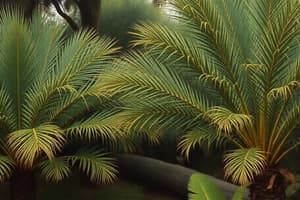Podcast
Questions and Answers
What are gymnosperms?
What are gymnosperms?
They are early plants with pollen and seeds (cone-bearing plants).
Why are gymnosperms called cone-bearing plants?
Why are gymnosperms called cone-bearing plants?
Because they form their pollen and seeds in cones.
How do cone-bearing plants reproduce?
How do cone-bearing plants reproduce?
By the alteration of generations cycle.
What happens in the male cones?
What happens in the male cones?
What happens in the female cones?
What happens in the female cones?
How do cone-bearing plants spread their seeds?
How do cone-bearing plants spread their seeds?
When did cone-bearing plants first appear in the fossil record?
When did cone-bearing plants first appear in the fossil record?
When were cone-bearing plants the dominant land plant?
When were cone-bearing plants the dominant land plant?
What do cone-bearing plants contain?
What do cone-bearing plants contain?
What do cone-bearing plants NOT contain?
What do cone-bearing plants NOT contain?
What do cone-bearing plants do with their spores instead of shedding them like ferns do?
What do cone-bearing plants do with their spores instead of shedding them like ferns do?
What are cone-bearing plants' spores surrounded by?
What are cone-bearing plants' spores surrounded by?
What does the spore form as it develops?
What does the spore form as it develops?
Where do the ovules form in cone-bearing plants?
Where do the ovules form in cone-bearing plants?
What are the most important and numerous cone-bearing plants?
What are the most important and numerous cone-bearing plants?
What are the less numerous cone-bearing plants?
What are the less numerous cone-bearing plants?
What cone-bearing plants were the predominant land plants during the dinosaur ages?
What cone-bearing plants were the predominant land plants during the dinosaur ages?
What are characteristics of conifers?
What are characteristics of conifers?
What do conifers provide to us in today's society?
What do conifers provide to us in today's society?
What are the three main types of conifers?
What are the three main types of conifers?
What characteristics must conifers contain in order to use wind pollination?
What characteristics must conifers contain in order to use wind pollination?
What percentage of lumber comes from conifers?
What percentage of lumber comes from conifers?
What type of wood do conifers supply us with?
What type of wood do conifers supply us with?
Do all cone-bearing plants have separate male and female cones?
Do all cone-bearing plants have separate male and female cones?
How much of all harvested wood is used for the production of paper?
How much of all harvested wood is used for the production of paper?
What does paper consist of?
What does paper consist of?
Strands of conifers cover large parts of the earth's surface, but where do they particularly exist?
Strands of conifers cover large parts of the earth's surface, but where do they particularly exist?
During the evolution of flowering plants, the ovule became surrounded by a layer of tissue, what is this tissue called?
During the evolution of flowering plants, the ovule became surrounded by a layer of tissue, what is this tissue called?
When did flowering plants evolve?
When did flowering plants evolve?
When did flowering plants become numerous?
When did flowering plants become numerous?
Do flowering plants contain flowers AND fruits?
Do flowering plants contain flowers AND fruits?
What is a major advantage of flowering plants?
What is a major advantage of flowering plants?
Flashcards are hidden until you start studying
Study Notes
Gymnosperms Overview
- Gymnosperms are early plant forms, known as cone-bearing plants, which produce pollen and seeds.
- Reproduction occurs through an alteration of generations cycle.
Cone Structure and Function
- Male cones develop spores that turn into pollen containing sperm cells.
- Female cones provide a protective jacket of cells for developing sperm.
Seed Dispersal
- Cone-bearing plants primarily spread their seeds via wind.
Fossil Record and Dominance
- First appeared in the fossil record approximately 350 million years ago.
- Dominated terrestrial ecosystems around 250 million years ago.
Plant Components
- Gymnosperms possess ovules, seeds, and pollen but lack flowers and fruits.
- They retain their spores, unlike ferns which shed them.
Development and Location of Ovules
- Ovules form on the surfaces of scales in cones and develop into eggs for fertilization.
Types of Cone-bearing Plants
- Most prevalent gymnosperms are conifers, including pines, spruces, firs, and redwoods.
- Cycads and ginkgos are less numerous but were prevalent during the dinosaur era.
Characteristics of Conifers
- Conifers include the largest plant species, retain spores, and rely on wind for pollination.
- They are bisexual, possessing both male and female cones.
Economic Importance of Conifers
- Conifers supply approximately 80% of global lumber and produce softwood.
- They are crucial for paper production, with around half of harvested wood used for this purpose.
Adaptation and Distribution
- Conifers thrive in northern latitudes, where they cover extensive regions.
- Large anthers and reduced leaf sizes are characteristics that enhance wind pollination.
Evolutionary Context
- Flowering plants emerged about 150 million years ago and became numerous 100 million years ago.
- Flowering plants provide advantages such as adaptability to dry land and contain both flowers and fruits.
Studying That Suits You
Use AI to generate personalized quizzes and flashcards to suit your learning preferences.




